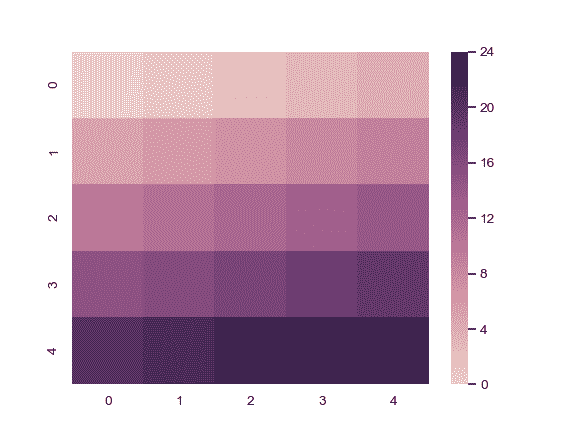# seaborn.cubehelix_palette
> 译者:[Modrisco](https://github.com/Modrisco)
```py
seaborn.cubehelix_palette(n_colors=6, start=0, rot=0.4, gamma=1.0, hue=0.8, light=0.85, dark=0.15, reverse=False, as_cmap=False)
```
用 cubehelix 系统制作顺序调色板。
生成亮度呈线性减小(或增大)的 colormap。这意味着 colormap 在转换为黑白模式时(用于打印)的信息将得到保留,且对色盲友好。“cubehelix” 也可以作为基于 matplotlib 的调色板使用,但此函数使用户可以更好地控制调色板的外观,并且具有一组不同的默认值。
除了使用这个函数,还可以在 seaborn 中使用字符串速记生成 cubehelix 调色板。 请参见下面的示例。
参数:`n_colors`:int
> 调色板中的颜色数。
`start`:float, 0 <= start <= 3
> 第一个色调。
`rot`:float
> 围绕调色板范围内的色相控制盘旋转。
`gamma`:float 0 <= gamma
> Gamma 系数用以强调较深 (Gamma < 1) 或较浅 (Gamma > 1) 的颜色。
`hue`:float, 0 <= hue <= 1
> 颜色的饱和度。
`dark`:float 0 <= dark <= 1
> 调色板中最暗颜色的强度。
`light`:float 0 <= light <= 1
> 调色板中最浅颜色的强度。
`reverse`:bool
> 如果为 True 值,则调色板将从暗到亮。
`as_cmap`:bool
> 如果为 True 值,则返回 matplotlib colormap 而不是颜色列表。
返回值:`palette or cmap`:seaborn 调色板或者 matplotlib colormap
> 类似列表的颜色对象的 RGB 元组,或者可以将连续值映射到颜色的 colormap 对象,具体取决于 `as_cmap` 参数的值。
另外
启动交互式小部件以调整 cubehelix 调色板参数。创建具有暗低值的连续调色板。创建具有亮低值的连续调色板。
参考
Green, D. A. (2011). “一种用于显示天文强度图像的配色方案”. Bulletin of the Astromical Society of India, Vol. 39, p. 289-295.
例子
生成默认调色板:
```py
>>> import seaborn as sns; sns.set()
>>> sns.palplot(sns.cubehelix_palette())
```

从相同的起始位置向后旋转:
```py
>>> sns.palplot(sns.cubehelix_palette(rot=-.4))
```

使用不同的起点和较短的旋转:
```py
>>> sns.palplot(sns.cubehelix_palette(start=2.8, rot=.1))
```

反转亮度渐变方向:
```py
>>> sns.palplot(sns.cubehelix_palette(reverse=True))
```

生成一个 colormap 对象:
```py
>>> from numpy import arange
>>> x = arange(25).reshape(5, 5)
>>> cmap = sns.cubehelix_palette(as_cmap=True)
>>> ax = sns.heatmap(x, cmap=cmap)
```

使用完整的亮度范围:
```py
>>> cmap = sns.cubehelix_palette(dark=0, light=1, as_cmap=True)
>>> ax = sns.heatmap(x, cmap=cmap)
```

使用 [`color_palette()`](seaborn.color_palette.html#seaborn.color_palette "seaborn.color_palette") 函数接口:
```py
>>> sns.palplot(sns.color_palette("ch:2,r=.2,l=.6"))
```

- seaborn 0.9 中文文档
- Seaborn 简介
- 安装和入门
- 可视化统计关系
- 可视化分类数据
- 可视化数据集的分布
- 线性关系可视化
- 构建结构化多图网格
- 控制图像的美学样式
- 选择调色板
- seaborn.relplot
- seaborn.scatterplot
- seaborn.lineplot
- seaborn.catplot
- seaborn.stripplot
- seaborn.swarmplot
- seaborn.boxplot
- seaborn.violinplot
- seaborn.boxenplot
- seaborn.pointplot
- seaborn.barplot
- seaborn.countplot
- seaborn.jointplot
- seaborn.pairplot
- seaborn.distplot
- seaborn.kdeplot
- seaborn.rugplot
- seaborn.lmplot
- seaborn.regplot
- seaborn.residplot
- seaborn.heatmap
- seaborn.clustermap
- seaborn.FacetGrid
- seaborn.FacetGrid.map
- seaborn.FacetGrid.map_dataframe
- seaborn.PairGrid
- seaborn.PairGrid.map
- seaborn.PairGrid.map_diag
- seaborn.PairGrid.map_offdiag
- seaborn.PairGrid.map_lower
- seaborn.PairGrid.map_upper
- seaborn.JointGrid
- seaborn.JointGrid.plot
- seaborn.JointGrid.plot_joint
- seaborn.JointGrid.plot_marginals
- seaborn.set
- seaborn.axes_style
- seaborn.set_style
- seaborn.plotting_context
- seaborn.set_context
- seaborn.set_color_codes
- seaborn.reset_defaults
- seaborn.reset_orig
- seaborn.set_palette
- seaborn.color_palette
- seaborn.husl_palette
- seaborn.hls_palette
- seaborn.cubehelix_palette
- seaborn.dark_palette
- seaborn.light_palette
- seaborn.diverging_palette
- seaborn.blend_palette
- seaborn.xkcd_palette
- seaborn.crayon_palette
- seaborn.mpl_palette
- seaborn.choose_colorbrewer_palette
- seaborn.choose_cubehelix_palette
- seaborn.choose_light_palette
- seaborn.choose_dark_palette
- seaborn.choose_diverging_palette
- seaborn.load_dataset
- seaborn.despine
- seaborn.desaturate
- seaborn.saturate
- seaborn.set_hls_values
